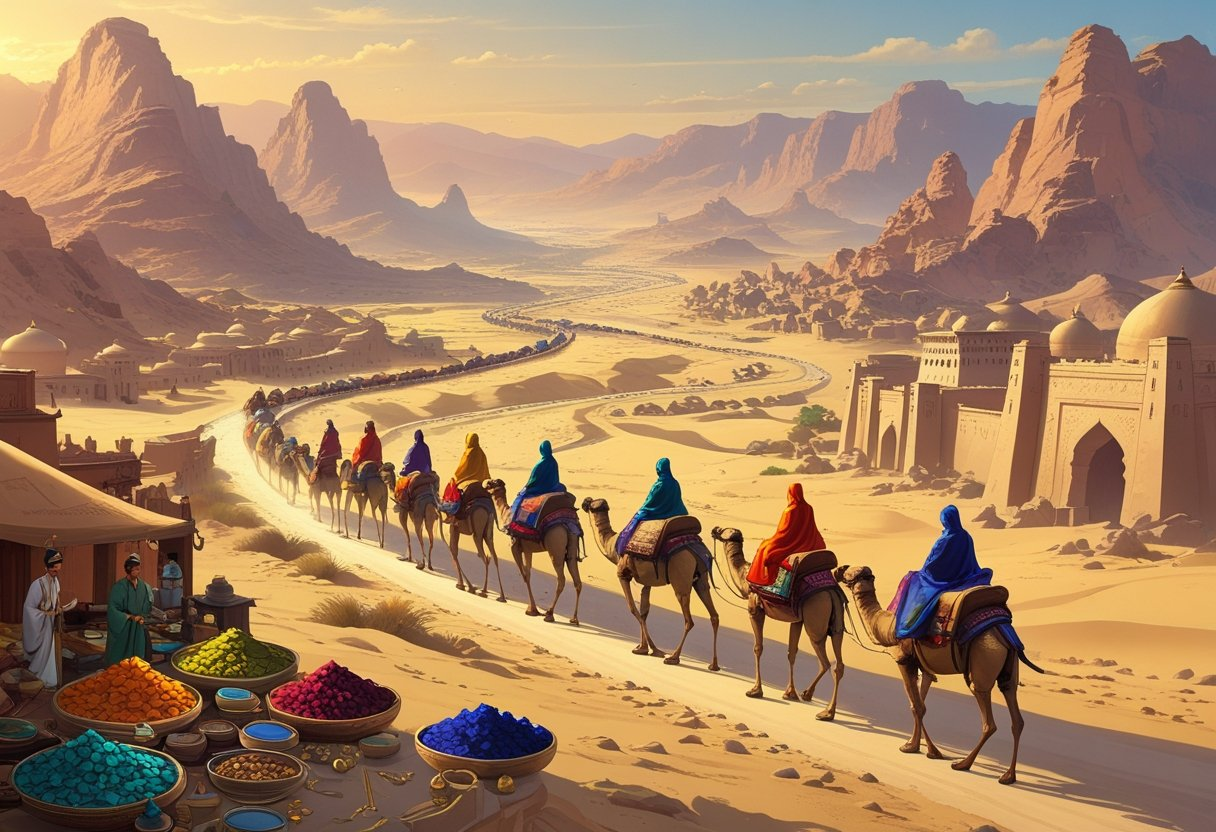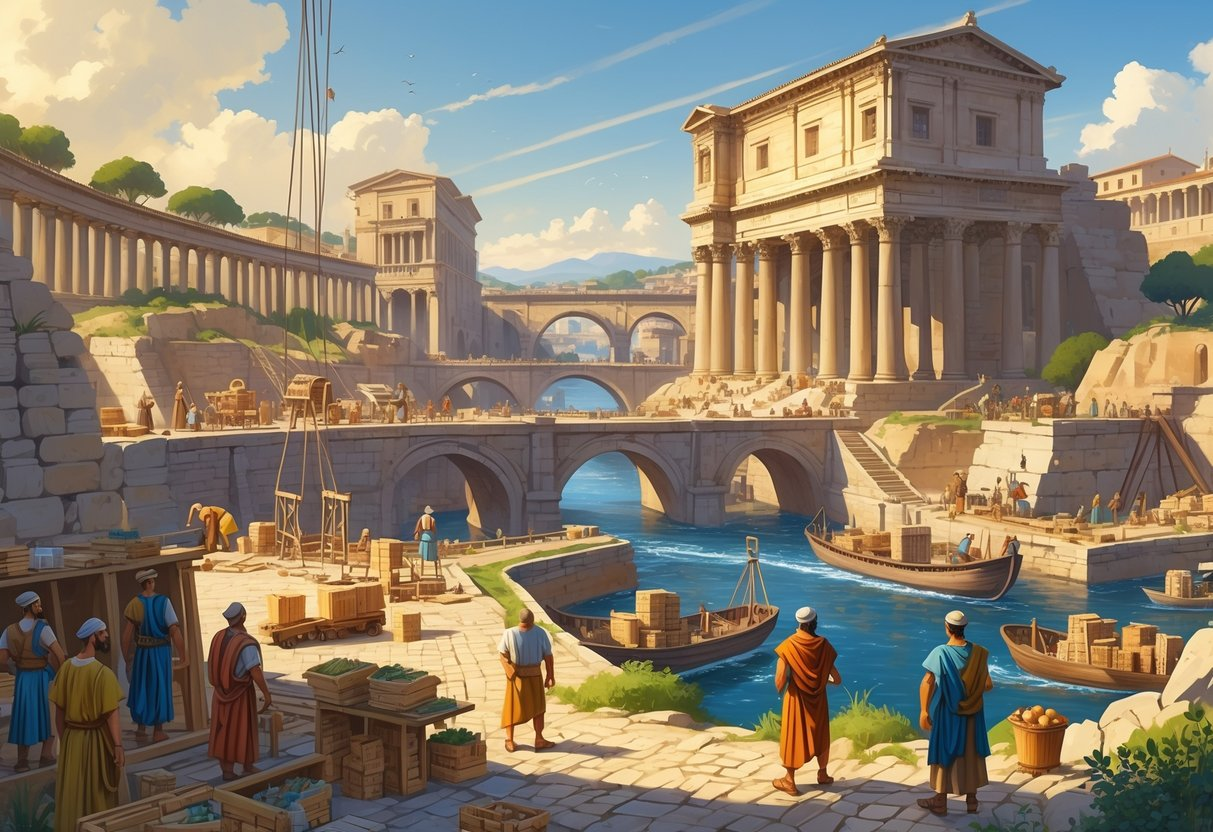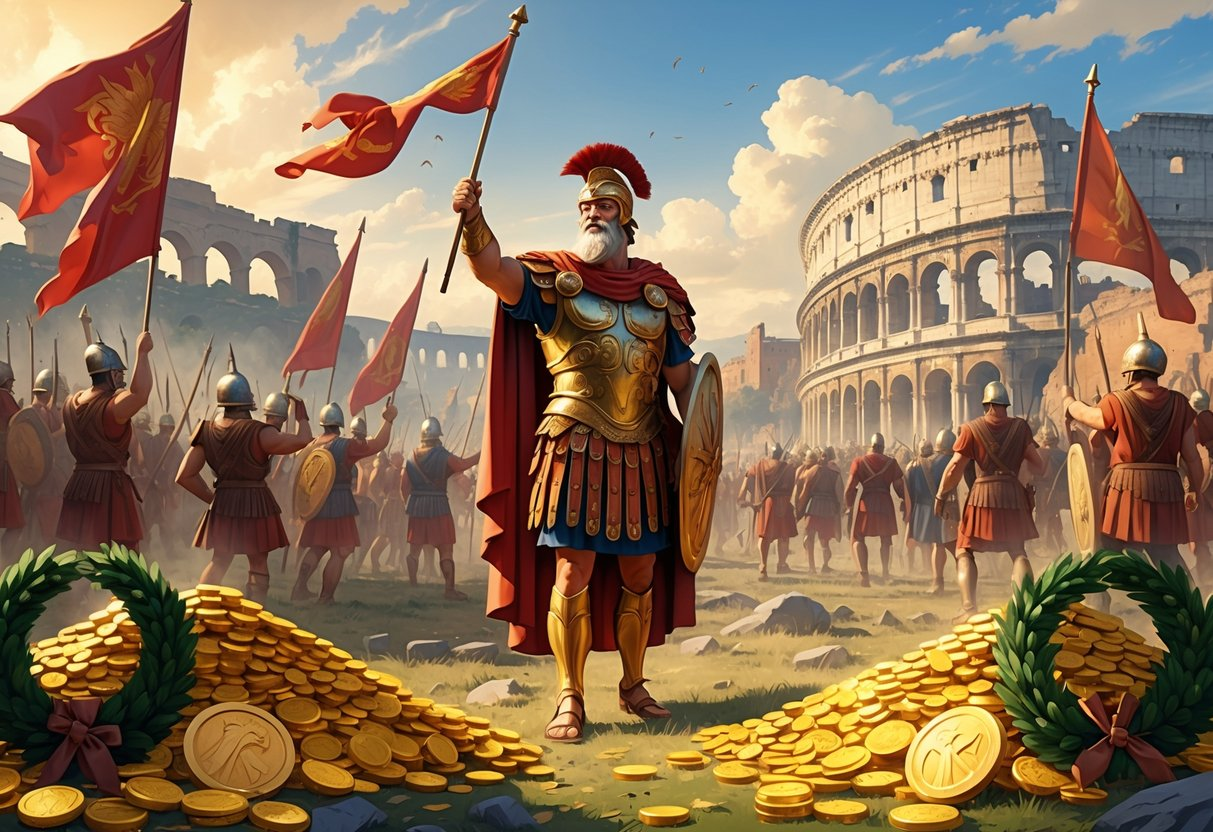The Silk Road was an ancient network of trade routes that connected Asia, Europe, and parts of Africa. It allowed merchants to exchange not only goods like silk, spices, and precious metals but also ideas, technologies, and cultures.
This vast trade system helped shape early global economies by linking distant regions in a way never seen before.

The birth of global trade began with the Silk Road, creating the first sustained connection between multiple regional economies across continents. It was more than just a path for goods—it was a channel for cultural exchange, spreading religions like Buddhism and innovations such as papermaking and new agricultural techniques.
The Han Dynasty played a key role in establishing these routes by protecting caravans and building diplomatic ties with distant empires. By doing so, they laid the groundwork for a world where trade and communication crossed vast distances.
Origins and Development of the Silk Road

The Silk Road began as a strategic effort to connect China with distant regions across the Asian continent. Its development involved careful political decisions, daring exploration missions, and the creation of a network that linked many cultures.
This network grew over time to include key trade routes that spanned from China to Europe’s doorstep.
Han Dynasty and the Foundation of the Silk Road
The Han Dynasty laid the groundwork for the Silk Road around the 2nd century BC. Faced with threats from nomadic tribes near the Great Wall of China, the Han rulers sought to secure their borders and open new trade paths westward.
The dynasty established military outposts and diplomatic ties that helped protect caravans and promote trade. Emperor Wu of Han played a crucial role by formalizing the trade routes and expanding Chinese influence west.
This period saw silk, horses, and other goods flow between China and regions beyond the Himalayas. Control over key areas in Central Asia allowed the Han to manage the emerging trade corridors effectively.
Role of Zhang Qian in Silk Road Exploration
Zhang Qian’s missions marked a turning point in the development of the Silk Road. Sent by Emperor Wu in 139 BC, Zhang traveled through harsh terrains to reach Central Asian kingdoms like Bactria and Parthia.
His reports introduced China to new cultures, goods, and political allies. Although Zhang was captured for several years before returning, his information sparked interest in expanding trade and forming alliances.
His journey helped link China to the broader Eurasian world, paving the way for direct contact with western civilizations, such as the Romans near Constantinople.
Expansion Through Eurasia and Key Trade Routes
After Zhang Qian’s exploration, the Silk Road expanded into a complex system of routes stretching over 6,400 kilometers. Traders crossed deserts like the Gobi and mountain ranges such as the Pamirs to carry silk, spices, and precious metals.
Major hubs emerged along the route, including cities in Central Asia and the Parthian capital, which acted as middlemen between China and Europe. The trade network facilitated not only goods but also the exchange of ideas, religions, and technologies across continents.
Goods, Commodities, and Economic Exchange

The Silk Road linked diverse regions through trade that included luxury goods, technology, and cultural ideas. Key goods such as silk, spices, and porcelain moved hand-in-hand with scientific advances.
This exchange fostered economic growth and the rise of important trade cities.
Silk Production and the Chinese Monopoly
China held a near-exclusive control over silk production for centuries. The Chinese perfected raising silkworms and weaving fine silk fabric, which became highly prized across Asia, Europe, and the Middle East.
Silk’s allure was both its softness and rarity. Chinese merchants guarded the secrets of silk production jealously.
This monopoly helped China gain wealth and influence. Silk was exchanged for horses, precious metals, and manufactured goods.
It was carried west along the Silk Road to places like Samarkand and Bukhara. Silk adorned royalty and the wealthy, symbolizing status and power across many cultures.
Trade in Spices, Textiles, and Luxury Goods
Spices such as cinnamon, pepper, and cloves were some of the most sought-after goods. They came mainly from South and Southeast Asia, traveling through caravan routes and maritime trade networks.
Spices influenced cuisine and medicine in Europe and the Middle East. Other important commodities included textiles beyond silk, like wool and cotton fabrics, and luxury goods such as glassware—Roman glass was especially prized in the East.
Porcelain from China was highly valued for its beauty and durability. Items like paper and precious metals also moved through these trade routes.
Traders exchanged goods with cities such as Baghdad, which served as a hub for luxury items.
Spread of Technological and Scientific Advances
The Silk Road was critical for spreading inventions and ideas. China shared key technologies like paper, gunpowder, printing, and the magnetic compass with the West.
These advances changed warfare, navigation, and communication worldwide. This flow of knowledge helped fuel economic growth and connected distant cultures.
For example, paper-making technology reached the Islamic world and then Europe, influencing education and record keeping. Mapping and navigation improvements helped merchants expand maritime trade.
Cities along the route became centers for learning, where scholars exchanged ideas alongside merchants.
Development of Trade Cities and Economic Hubs
Cities like Samarkand, Bukhara, and Baghdad grew wealthy by serving as key stops on the Silk Road. They acted as markets, storage centers, and places for cultural exchange.
Their location helped control trade routes linking East and West. These cities attracted merchants, artisans, and scholars.
They developed financial systems to support long-distance trade, which boosted regional economies. Trade increased demand for luxury goods and improved infrastructure.
As a result, these hubs became focal points for economic activity, facilitating global connections that shaped the early world economy.
Cultural Exchange and the Spread of Ideas
The Silk Road was more than a trade route for goods; it was a path for sharing beliefs, art, and knowledge. Different religions traveled these routes, shaping cultures from Asia to the Middle East and beyond.
Art and architecture evolved as new styles mixed, showing the deep impact of cultural exchange.
Religious Diffusion: Buddhism, Christianity, and Islam
Buddhism spread from India across Central Asia to China through Silk Road networks. Merchants and monks carried Buddhist texts and teachings, helping convert many along the way.
This movement influenced many regions, integrating local beliefs. Christianity spread mainly in the western parts of the Silk Road, particularly within the Roman Empire and Middle East.
Nestorian Christians used trade routes for travel and spread their faith eastward. Islam expanded after the 7th century, reaching Persia and Central Asia quickly.
Muslim traders and missionaries played a significant role in sharing Islamic culture and laws along these routes. This religious diffusion created a complex mix of beliefs in many Silk Road cities.
Buddhist Art and Architectural Influences
Buddhist art flourished along the Silk Road, blending Indian, Persian, and Chinese styles. Sculptures and paintings often featured symbols like the lotus flower and Buddha images adapted to local tastes.
Architecture also changed. Rock-cut caves in India inspired similar carvings in Central Asia and China, like the famous Mogao Caves near Dunhuang.
These sites became centers for Buddhist learning and art. The spread of Buddhist art shows how culture moved beyond borders.
It became a shared language that connected distant peoples with spiritual and artistic expressions.
Cultural Integration Across Regions
The Silk Road connected Persia, India, the Middle East, and parts of the Roman Empire. Cities along these routes became melting pots of languages, customs, and ideas.
Zoroastrianism from Persia met Buddhist and Islamic beliefs, leading to new cultural blends. Trade brought not only goods but also knowledge about medicine, astronomy, and technology.
This cultural integration helped create early forms of globalization. It allowed different societies to learn from each other and adapt new ways of life.
| Region | Key Cultural Impact | Major Religion(s) |
|---|---|---|
| India | Origin and spread of Buddhism | Buddhism |
| Persia | Blend of Zoroastrian and Islamic ideas | Zoroastrianism, Islam |
| Middle East | Spread of Christianity and Islam | Christianity, Islam |
| Central Asia | Mix of Buddhist, Islamic art | Buddhism, Islam |
| Roman Empire | Exchange of Christianity | Christianity |
Maritime Routes and Expanding Global Connectivity
Maritime routes transformed trade by connecting Asia, Africa, and Europe with faster and more efficient seafaring paths. These routes enabled a flow of goods, culture, and technology that shaped global markets and linked distant regions through ports and trading hubs.
Emergence of Maritime Silk Road
The Maritime Silk Road began around the 2nd century BCE as sea routes complemented the overland Silk Road. It connected China with Southeast Asia, the Indian subcontinent, and beyond through the South China Sea and the Indian Ocean.
Mariners used the monsoon winds to travel quickly across vast waters. This allowed for the transport of silk, spices, precious stones, and textiles.
Ports along these routes flourished, becoming centers of trade, culture, and exchange. Technological advances in navigation and shipbuilding supported longer voyages.
The magnetic compass, for example, was crucial for sailors crossing unpredictable waters.
Trade Across the Indian Ocean and Africa
The Indian Ocean acted as a major highway connecting East Africa, Arabia, South Asia, and Southeast Asia. African ports on the Swahili Coast played key roles in trading gold, ivory, and other goods.
Ships from the Arabian Peninsula and the Levant linked Africa and Asia, moving spices, textiles, and metals. This network encouraged cultural exchanges among traders of different backgrounds.
The Indian Ocean trade routes also contributed to the rise of influential cities in North Africa and around the Red Sea.
Role of Southeast Asia and the Levant
Southeast Asia served as a critical crossroads in the Maritime Silk Road. Its strategic position allowed merchants to control the passage of goods from China to India and the Middle East.
The Levant acted as the gateway between the Mediterranean and Asian markets. Traders in Levantine ports like those near the Caspian Sea connected maritime paths with overland routes reaching cities such as Bukhara.
These regions were not only transit points but also melting pots of ideas, religions, and technologies.
Age of Exploration: Vasco da Gama and Beyond
In the late 15th century, Vasco da Gama’s voyage around Africa to India marked a new chapter in maritime trade. His route opened direct sea access from Europe to Asia via the Indian Ocean.
This breakthrough reduced reliance on overland routes through the Middle East and Levant, shifting global trade dynamics. European powers began establishing colonies and ports along these sea lanes.
The new routes intensified exchange of goods like spices, textiles, and precious metals. Maritime trade thus became the backbone of emerging global commerce systems.
Challenges, Decline, and the Silk Road’s Enduring Impact
The Silk Road faced several major obstacles that led to its decline. Political changes disrupted trade routes, and deadly diseases spread along these paths.
Despite its decline, the Silk Road’s influence continues today through modern trade projects and global connectivity efforts.
Political Instability and Shifts in Power
Political instability along the Silk Road routes weakened its safety and efficiency. The rise and fall of empires, such as the Mongol Empire and the Ottoman Empire, shifted control over key regions like Iran and Central Asia.
Conflicts and border changes often disrupted trade. The Ottoman Empire’s control of important land routes limited access for European traders, pushing them to seek sea routes instead.
This shift reduced the Silk Road’s role in global trade. Additionally, internal conflicts and changing political borders made overland trade less secure and less reliable.
Disease Transmission and the Black Death
The Silk Road was a pathway not only for goods but also for diseases. The Black Death, or bubonic plague, traveled along these routes during the 14th century.
It spread from Asia to Europe, causing widespread death and social disruption. This epidemic deeply affected populations along the Silk Road and beyond.
The movement of traders and caravans helped the disease spread quickly over vast distances.
Transition to Modern Trade and the Belt and Road Initiative
As maritime trade routes grew safer and more efficient, the Silk Road’s importance declined. Sea routes bypassed many overland dangers and allowed larger volumes of goods to move faster.
This transition marked a shift toward modern global trade systems. Today, the Belt and Road Initiative (BRI), led by China, revives parts of the Silk Road spirit.
It aims to connect Asia, Europe, and Africa through infrastructure projects. This plan reflects lessons from history by promoting economic integration and cooperation among many countries, including Iran.
| Aspect | Silk Road Era | Belt and Road Initiative |
|---|---|---|
| Trade Routes | Overland, risky, slow | Modern infrastructure, faster |
| Control | Empires like Mongols/Ottomans | Multi-country partnerships |
| Risks | Bandits, political conflicts | Economic and diplomatic challenges |
| Impact on Globalization | Began integration of cultures | Expands global trade networks |
Legacy of the Silk Road in Modern Global Trade
The Silk Road shaped early connections between East and West. These connections set the stage for today’s complex global economy.
Its lasting impact includes economic influences and cultural heritage. Modern efforts continue to preserve and revive these ancient routes.
Silk Road’s Influence on Today’s Global Economy
The Silk Road introduced early forms of global trade by linking Asia with Europe and beyond. Though trade along the routes was often small-scale and local, it encouraged the exchange of goods, ideas, and technologies.
One key example is the spread of the printing press concept. This technology originated in China and later influenced Europe through Silk Road contacts.
Its role in transferring technologies like paper and silk helped shape industries across continents. These exchanges laid the groundwork for a connected world economy.
Historical Significance and Cultural Heritage
Beyond goods, the Silk Road was a passage for cultural and religious ideas. Buddhism, Zoroastrianism, and other faiths moved along these routes.
This created a legacy of tolerance and diversity in the regions along the way. The route’s rich historical records and artifacts provide unique insights into the daily lives of traders, missionaries, and refugees.
These materials help historians understand how societies mixed languages, customs, and technologies. This cultural exchange was as influential as any commercial activity.
Recognition as a World Heritage and Modern Revivals
The Silk Road is now recognized for its cultural and historical value by organizations like UNESCO. Many Silk Road sites across Asia have earned World Heritage status, protecting ancient cities, caravanserais, and artifacts.
Modern governments and international groups seek to revive the Silk Road concept to boost regional trade and cooperation. These efforts aim to recreate ancient networks for transportation and commerce but on a much larger scale.




Leave a Reply